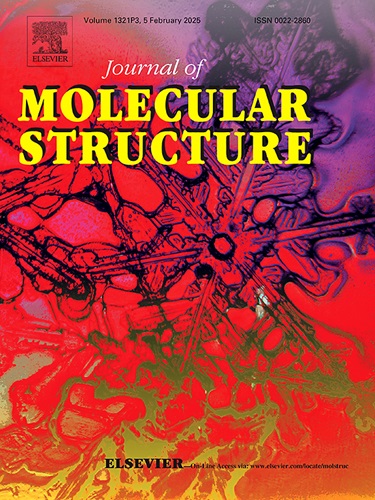一种新型褐黄酮类似物与DNA和人血清白蛋白相互作用的实验和计算研究
IF 4
2区 化学
Q2 CHEMISTRY, PHYSICAL
引用次数: 0
摘要
药物主要通过血浆蛋白,包括人血清白蛋白(HSA)转运到靶组织。HSA是人体血浆中含量最丰富的蛋白质,作为药物、染料、离子等多种物质的载体发挥着重要作用。因此,药物- hsa相互作用的分析在药物开发中具有重要的药理学意义,这需要在细胞和分子水平上对相互作用有透彻的了解。许多抗癌药物也通过与DNA相互作用来发挥其生物活性。本研究通过实验分析和硅对接方法研究了一种潜在的抗癌药物fusarochromanone类似物(FC101g)与DNA和HSA的相互作用。结果表明,FC101g与HSA结合域i的IA和IB子域发生疏水相互作用。ΔS和ΔH的正值表明这些相互作用主要由范德华相互作用和氢键构成。结果还表明,DNA对FC101g的荧光猝灭是一个静态猝灭过程,相关的结合力包括范德华相互作用和氢键。分子模拟结果表明,FC101g结合在DNA的小凹槽内。这些结果可能在药理学和药物化学方面有一定的应用价值,并为今后的研究提供新的思路。本文章由计算机程序翻译,如有差异,请以英文原文为准。

Experimental and computational studies of the interactions of a novel fusarochromanone analog with DNA and human serum albumin
Drugs are primarily transported to target tissues by plasma proteins, including human serum albumin (HSA). HSA is the most abundant protein in human blood plasma, and it plays an important role as a carrier for various substances, including drugs, dyes, and ions. Hence, the analysis of drug-HSA interactions is pharmacologically important in drug development, which requires a thorough understanding of interactions at the cellular and molecular levels. Many anticancer drugs also exert their biological activity by interacting with DNA. This study investigates the interaction of a fusarochromanone analog (FC101g), a potential anticancer drug with both DNA and HSA through experimental assays and in silico docking methods. The results demonstrate that FC101g exhibits hydrophobic interactions with subdomains IA and IB in HSA binding domain I. The positive values of ΔS and ΔH indicate that van der Waals interactions and hydrogen bonds primarily constitute these interactions. The results also indicate that the fluorescence extinction of FC101g by DNA is a static quenching process, and the relevant binding forces consist of van der Waals interactions and hydrogen bonding. The molecular modeling results show that FC101g binds within the minor groove of DNA. These results may be useful in pharmacology and medicinal chemistry and provide new insights for future studies.
求助全文
通过发布文献求助,成功后即可免费获取论文全文。
去求助
来源期刊

Journal of Molecular Structure
化学-物理化学
CiteScore
7.10
自引率
15.80%
发文量
2384
审稿时长
45 days
期刊介绍:
The Journal of Molecular Structure is dedicated to the publication of full-length articles and review papers, providing important new structural information on all types of chemical species including:
• Stable and unstable molecules in all types of environments (vapour, molecular beam, liquid, solution, liquid crystal, solid state, matrix-isolated, surface-absorbed etc.)
• Chemical intermediates
• Molecules in excited states
• Biological molecules
• Polymers.
The methods used may include any combination of spectroscopic and non-spectroscopic techniques, for example:
• Infrared spectroscopy (mid, far, near)
• Raman spectroscopy and non-linear Raman methods (CARS, etc.)
• Electronic absorption spectroscopy
• Optical rotatory dispersion and circular dichroism
• Fluorescence and phosphorescence techniques
• Electron spectroscopies (PES, XPS), EXAFS, etc.
• Microwave spectroscopy
• Electron diffraction
• NMR and ESR spectroscopies
• Mössbauer spectroscopy
• X-ray crystallography
• Charge Density Analyses
• Computational Studies (supplementing experimental methods)
We encourage publications combining theoretical and experimental approaches. The structural insights gained by the studies should be correlated with the properties, activity and/ or reactivity of the molecule under investigation and the relevance of this molecule and its implications should be discussed.
 求助内容:
求助内容: 应助结果提醒方式:
应助结果提醒方式:


